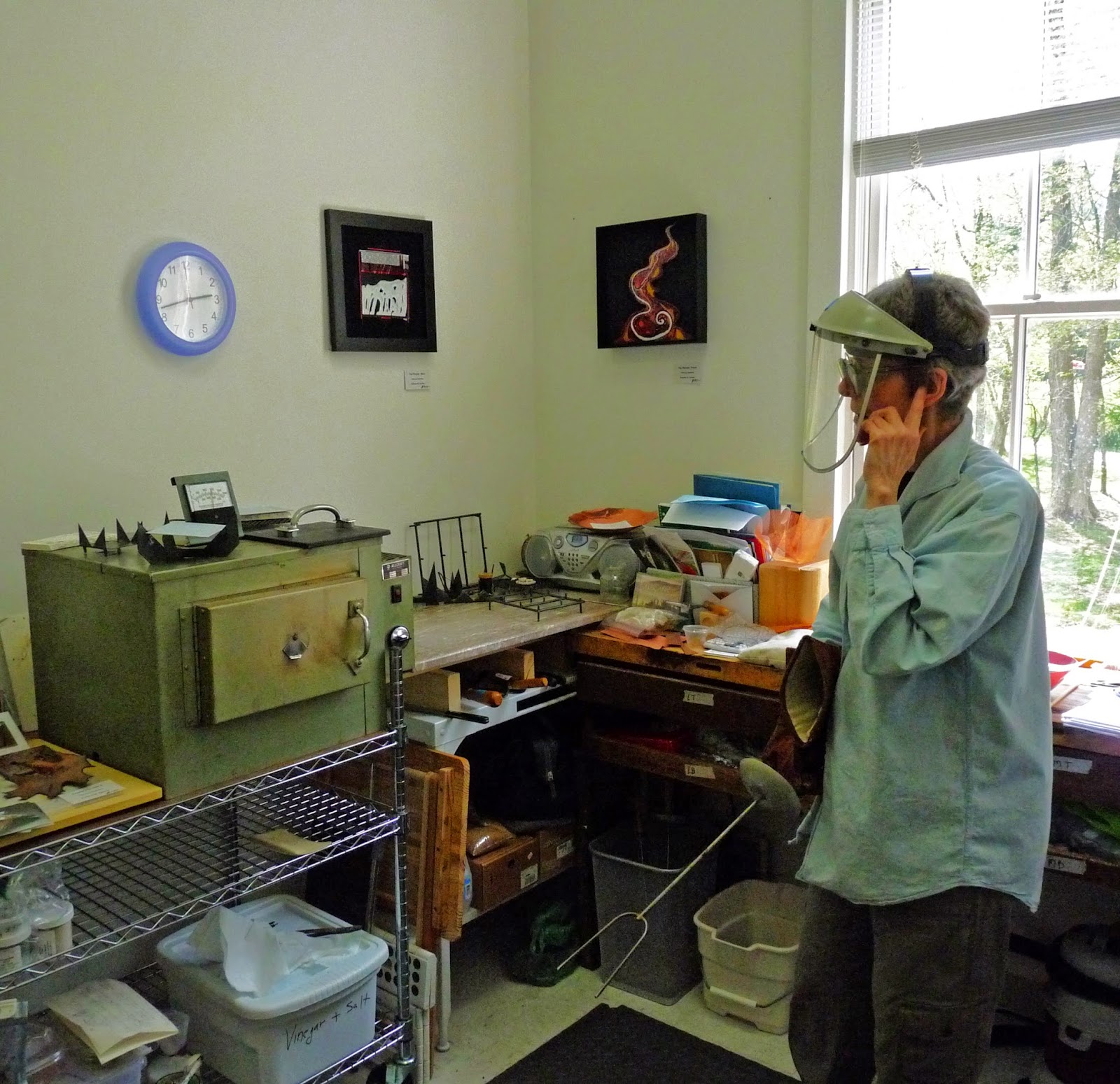I found I could say things with color and shapes that
I couldn't say any other way - things I had no words for.
~ Georgia O'Keeffe
Susana Garten sometimes can’t get her pieces to do what she wants. She was working on a wall piece with 2” squares of 22/24 gauge copper, she was hammering away, but it just wouldn’t cooperate, so she took it out to her driveway and ran over it a few times. Perfect!
While Sue was at MC working on her degree in Art, she took Jan Maddox’s 2-D/3-D Survey of Crafts class. At first she couldn’t decide between weaving and enamel, but the way color and texture could be worked in the enamel “sealed the deal” and “so much for the degree!” In 1997 Sue was invited to be a guest artist in the Pleiades Art Jewelry show, shortly thereafter she joined as a member.
Initially she created cloisonné jewelry, but soon moved onto smaller vessels, hammering out bowl forms (now she uses spun forms and shaping) in copper and switched to “basse-taille[1], firescale[2] and precious foil enamel techniques as a means of expression.”[3] Sue also does a fair amount of etching (resist, asphalt, contact paper – ferric acid – sometimes adding cloisonné wire – sometimes stencils – cleaning, washing – lay on enamel – fire over and over again). Still you never really know exactly what the end result will be or even exactly when the end will be. Occasionally a piece she thinks will be marvelous turns out horrible, so she puts it away and returns to it later. One piece she came back to, she stepped on a bit and it turned out to be terrific.
 Sue finds that she constantly learns something from teaching enamel workshops and classes. "Someone always asks a question I had never thought of!" Since she doesn't like making frames, her wall pieces tend to be more abstract. "Some idea, some inspiration that leads to the design. My style is all over the place. I like to experiment. Having started doing cloisonne my work has gotten freer, more playing around and the more playing around the more I want to do." Sue takes her inspiration from nature, fiber, everyday occurrences, random internal thoughts and texture, color and pattern play important roles in every piece.
Sue finds that she constantly learns something from teaching enamel workshops and classes. "Someone always asks a question I had never thought of!" Since she doesn't like making frames, her wall pieces tend to be more abstract. "Some idea, some inspiration that leads to the design. My style is all over the place. I like to experiment. Having started doing cloisonne my work has gotten freer, more playing around and the more playing around the more I want to do." Sue takes her inspiration from nature, fiber, everyday occurrences, random internal thoughts and texture, color and pattern play important roles in every piece.
While she loves making the larger vessels and wall pieces, reality may cause a return to jewelry, holding the weight of an 18 gauge bowl while putting the enamel on is taking its toll. For now, however, she’s busy creating a collection of new work to present both at the Pleiades Show, but also for an exhibit of her work at Glenview Mansion opening October 5 of 16-24 pieces, a "Teacher's Pet" show with former students at the Pearson Legacy Gallery in Deer Isle Maine October 8-26 and for the Washington Guild of Goldsmiths show in November.
If you would like to see more or to contact Sue to purchase a piece please check her website.
[1]A low-relief pattern in metal, usually silver or gold, by engraving or chasing. The entire pattern is created in such a way that its highest point is lower than the surrounding metal. A translucent enamel is then applied to the metal, allowing light to reflect from the relief and creating an artistic effect. It was used in the late Middle Ages, and then again in the 17th century. The Art of Fine Enameling
[2] The use of the oxide buildup on a metal. Some pieces are completely done through firescale manipulation (by painting with a holding agent, sifting transparent enamels, and building up the resulting firescale lines), and some pieces are enhanced by the additive use of firescale (could be from a flaked-off piece that is reattached). The Art of Fine Enameling
[3] http://susanagarten.com/home.html






No comments:
Post a Comment